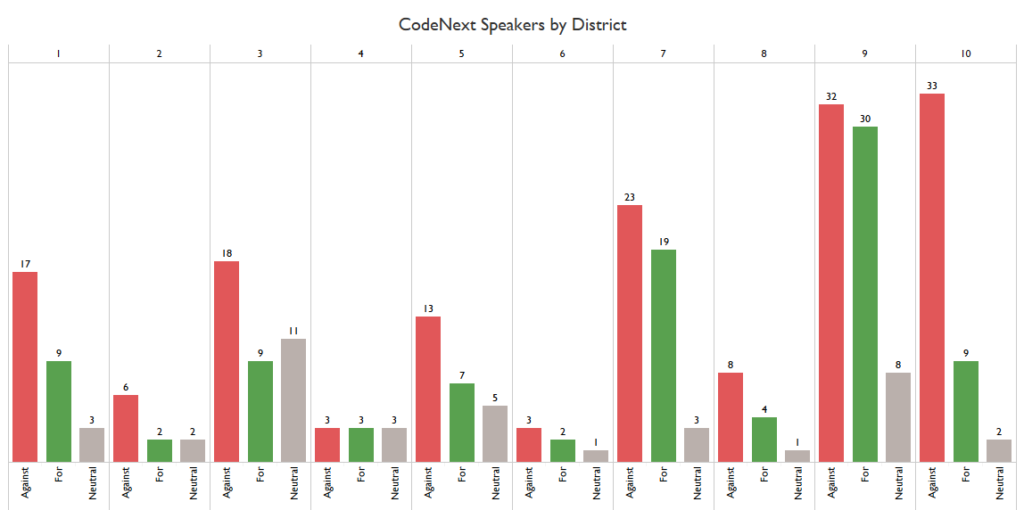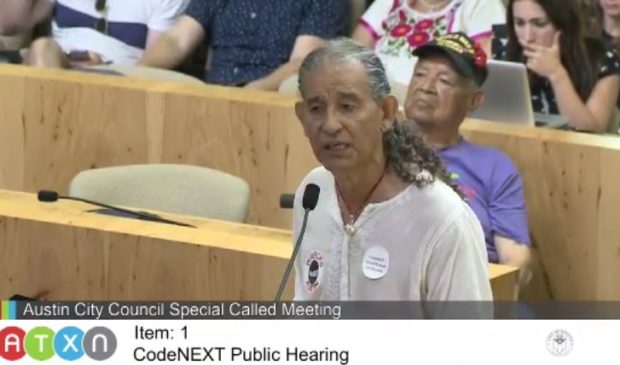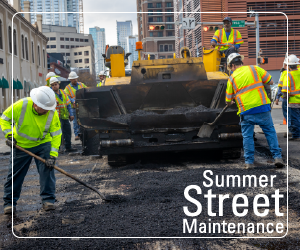Some areas of the city care a lot more about CodeNEXT
Wednesday, July 11, 2018 by
Jack Craver What do Austinites think about CodeNEXT? It’s hard to say.
A poll conducted by the Austin Chamber of Commerce, which supports CodeNEXT, found 45 percent in favor, 36 percent opposed and 19 percent unsure.
When City Council recently held two public hearings for residents to voice their opinions on the proposed overhaul of the Land Development Code, 170 said they were opposed, 99 said they were in favor and 47 rated their position as “neutral.”
What is clear, however, is that some parts of the city are far more engaged on the issue than others. Here is a look at those who turned up at the CodeNEXT meetings.

Out in Force: Districts 9, 7, 10
On one end of the spectrum is District 9, which includes downtown, the University of Texas campus and many of the nearby Central Austin neighborhoods. Seventy residents from the district showed up at the meetings. Some addressed Council, while others donated their time to others and some simply registered their position in writing.
The district is represented on Council by Mayor Pro Tem Kathie Tovo, one of the leading critics of the proposed code overhaul (at least as it is currently written). She suggested that her constituents were particularly engaged on the issue because the proposal “has directed a great deal of change towards central neighborhoods.”
The residents who came to the hearings appeared mixed in their views about whether those changes are a good thing: 32 said they were against CodeNEXT, 30 were in favor and eight were neutral.
The next-greatest turnout came from District 7, which is represented by Council Member Leslie Pool, another CodeNEXT critic, and stretches north from the Brentwood and Allandale neighborhoods up to the northern edges of the city on Howard Lane. The 45 from the 7th were also fairly evenly split, with 19 in favor, 23 against and three neutral.
However, the 44 who showed up from District 10, the West Austin district that boasts by far the city’s highest median income, were decidedly critical of the proposed new code: 33 were against, nine were in favor and two were neutral.
Middle of the Pack: Districts 3, 1, 5
In the middle of the pack were Districts 5, 3 and 1. Districts 3 and 1 are largely made up of East Austin neighborhoods that historically did not have significant wealth or influence at City Hall, but which have experienced significant gentrification in recent years.
District 5 includes a diverse array of neighborhoods south of the river – the affluent Zilker, the historically working-class but gentrifying Galindo, and the far-south suburbs of Onion Creek.
Those who attended the hearings from these districts were twice as likely to oppose CodeNEXT as support it, although a notably large contingent of District 3 residents registered as neutral.
CodeWhat?: Districts 2, 4, 6, 8
At the other end of the spectrum is District 6, which is made up of far-northwest suburbs. Only six people from that district showed up: two in favor, three against and one neutral.
Council Member Jimmy Flannigan said that the low turnout from his district at City Hall was “not atypical,” a trend that he said was at least partially a result of geography.
“It is a big ask to ask people from District 6 to come down to City Council,” he said.
Flannigan, an outspoken supporter of allowing more density in the urban core, said that while he didn’t think the current CodeNEXT proposal would lead to major changes anywhere in the city, its impact would be almost negligible in his district.
“There doesn’t seem to be anything in District 6 that you can point to (changing),” he said.
Similarly, only 13 people showed up from District 8, which comprises largely southwestern suburbs. Much of that district is under strict development regulations due to the Save Our Springs Ordinance, which CodeNEXT will not change.
Districts 2 and 4 saw only 10 and nine people at the hearings, respectively. Both of those districts are at least two-thirds Latino and have high poverty rates, but they have not experienced nearly as much gentrification as the two other east side districts.
Council Member Greg Casar, who represents District 4, said that the low turnout at City Hall should not suggest that his constituents don’t care. Many of them are engaging in other ways, he said, including at meetings in the district.
Casar acknowledged, however, that a lack of engagement in poorer areas of the community is partially a legacy of the former at-large Council system, whose members were elected in low-turnout elections in May.
“I think it shows the lack of investment in building civic institutions outside of many of the traditional places (of power),” he said.
Photo: Daniel Llanes testifies about CodeNEXT at a special called City Council meeting, taken from ATXN. Graph of speaker responses by Jen Winter Craver.
The Austin Monitor’s work is made possible by donations from the community. Though our reporting covers donors from time to time, we are careful to keep business and editorial efforts separate while maintaining transparency. A complete list of donors is available here, and our code of ethics is explained here.
You're a community leader
And we’re honored you look to us for serious, in-depth news. You know a strong community needs local and dedicated watchdog reporting. We’re here for you and that won’t change. Now will you take the powerful next step and support our nonprofit news organization?





